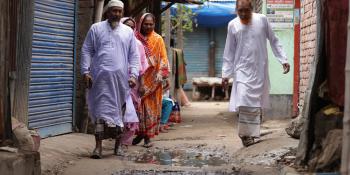215 million
people potentially impacted by climate migration by 2050
68%
people worldwide expected to live in cities by 2050 – that’s 2 in every 3
1.1 billion
people currently living in slums or other informal settlements
In a new issue brief, Habitat uncovers a massive and growing blind spot in the discourse around climate change-induced migration and adaptation efforts: “Slum Blind: The overlooked links between climate migration and informal settlements.”
Public discourse in general tends to center around refugees from low/mid-income countries arriving in high-income countries, but most migration does not cross international borders. If world leaders fail to focus on climate migration within the Global South, which represents the vast majority of human movement, they are missing a massive piece of the puzzle and an opportunity to tackle critical issues — from economic development to health and education.
Climate migration has the potential to impact over 215 million people by 2050 and affect the lowest-income and most rapidly urbanizing countries the most. This blind spot is preventing world leaders from seeing an important part of the future, where climate change-induced migration meets informal settlements.
Most climate migrants are moving from rural to urban areas within their own countries, often residing in slums and other informal settlements.
- By 2050, 2 out of every 3 people in the world — 68% — are expected to live in cities.
- Ninety percent of this growth will happen in Asia and Africa, where 80% of the world’s informal settlements are located.
- The number of people living in slums or other informal settlements has grown by 165 million in the past 20 years, bringing the total to nearly 1.1 billion.
India, Nigeria, Pakistan, Bangladesh, Indonesia and the Philippines are among the countries with large populations living in urban informal settlements that will likely face the largest numbers of internal climate migrants by 2050. Applying a climate migration lens to policies for upgrading informal settlements is crucial in all countries, but particularly so in these areas.
In the brief, Habitat calls attention to the opportunity to promote climate adaptation in the places where people need it most —especially in informal settlements, which host most climate-induced migrants within low/mid-income countries.



